- Home
- Ricoh Global Newsroom
- Stories
- Diversity Fortifies People and Organizations
Special Dialogue
2022.03.04
Diversity Fortifies People and Organizations
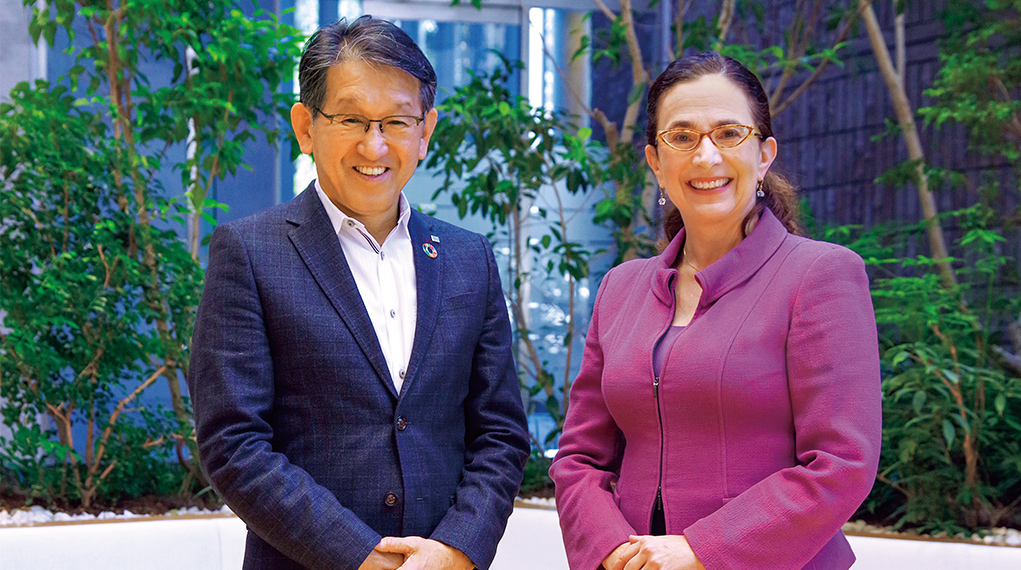
Left
Yoshinori “Jake” Yamashita
President & CEO
Right
Christina L. Ahmadjian
Professor, Graduate School of Business Administration, Hitotsubashi University
She has taught courses in organizational behavior, leadership, management, and corporate governance at Hitotsubashi University since 2001 and been at the current position since April 2018. She is an outside director of Japan Exchange Group, Inc. and provides training and consulting services to many Japanese and multinational companies.
Index
- Diversity and Inclusion Drives Innovation, Corporate Culture that Motivates Diverse Employees
- The COVID-19 pandemic disaster has upended norms, with ingenuity broadening choices
- Reviewing work practices to create an equitable environment in which Japan can regain its diversity
- Implementing a job-based employment structure and trusting people rather than worrying about them
- Becoming truly global by accommodating diverse perspectives
- “Jump out of your comfort zone” “Put your thoughts into words and give them shape”
Diversity and Inclusion Drives Innovation,
Corporate Culture that Motivates Diverse Employees
Ricoh is becoming a digital services company. Diversity and Inclusion (D&I) is vital to innovate for such a transformation. Organizational sociology specialist Professor Christina Ahmadjian of Hitotsubashi University’s Graduate School of Business Administration spoke with Jake Yamashita, President and CEO of Ricoh, about the essence of diversity and the keys to attaining D&I in organizations.
The COVID-19 pandemic disaster has upended norms, with ingenuity broadening choices
Yamashita: The COVID-19 pandemic changed a lot at Ricoh. That said, we had previously embarked on overhauling our work practices, enabling employees to apply to work from home or satellite offices. After the Japanese government declared a series of states of emergency, employees had to submit applications to work at the office. The pandemic upended norms, and we've seen that as an opportunity to transform the world of work.
Ahmadjian: While quite a few things have changed, technology has made communications easier than expected. I’m an outside director for four companies. I’ve attended most board meetings from home over the past 18 months or so. I’ve engaged in wide-ranging deliberations and maintained good relationships with other board members. Lectures and tutorials at my university have been online for the past two years as well. Remote learning has actually enhanced student engagement. We’ve been able to enjoy fruitful discussions.
Yamashita: Participants in Ricoh's management meetings can also freely choose between the options of in-person or remote attendance, as they prefer. This policy seems to have livened up deliberations. That could be because teleconference participants find job titles less relevant. For employees, remote and on-site processes for producing outputs and contributing to the company don’t differ all that much. It’s essential to broaden alternatives, enable people to be creative, show initiative, and draw on an array of options to work better.
Ahmadjian: Being able to choose how best to get things done according to personal, job, and situational needs is vital to fostering diversity and inclusion (D&I), which is what we’ll mainly discuss today.
Yamashita: People generally think of diversity in terms of empowering women, hiring individuals with disabilities, and hiring more non-Japanese employees. But I feel uncomfortable just setting targets without adequately discussing the need for D&I and the importance of women’s empowerment.
Ahmadjian: Why do we need D&I? Simply put, half of the population is female. We surely have to harness women’s potential. How can we overcome intensifying global competition in the absence of differences in gender, nationality, and educational level?
Yamashita: After returning to Japan following an overseas assignment, I recall attending a lecture by British organizational theorist Lynda Gratton. She authored “The Shift: The Future of Work Is Already Here.” I asked her, “How can you drive innovations for new business?” She responded, “Put it this way: Are you having the same meeting with the same people in the same room in which you met yesterday to discuss what to do about new business?” She helped me realize that people following the same routine day after day could never innovate.
Ahmadjian: That’s an interesting story.
Yamashita: Half of our customers are women. We also serve people with disabilities. Our employee mix should naturally match the diversity of our customer base. The first step should be to discuss and put the proper structure in place and then set targets, such as female employee and manager ratios.
Ahmadjian: That’s the right way to go. And it’s important to emphasize differences not just in terms of gender, nationality, disability levels, and the like but also with respect to individual experiences, sensitivities, and points of view. I believe that’s the essence of diversity. If you hire people with different attributes and acknowledge differences in their individual experiences, sensitivities, and thought patterns, you can generate diverse ideas that lead to innovation.
Yamashita: I recently attended a board meeting of Business for Inclusive Growth*. Ricoh was the first Asian company to participate in that initiative, which was launched in August 2019. Ricoh endeavors to resolve social issues through initiatives related to that entity, focusing particularly on the digital divide. I believe that we will be able to attain inclusion through such activities by accepting the differences of diverse people and fully tapping their talents while leaving no one behind.
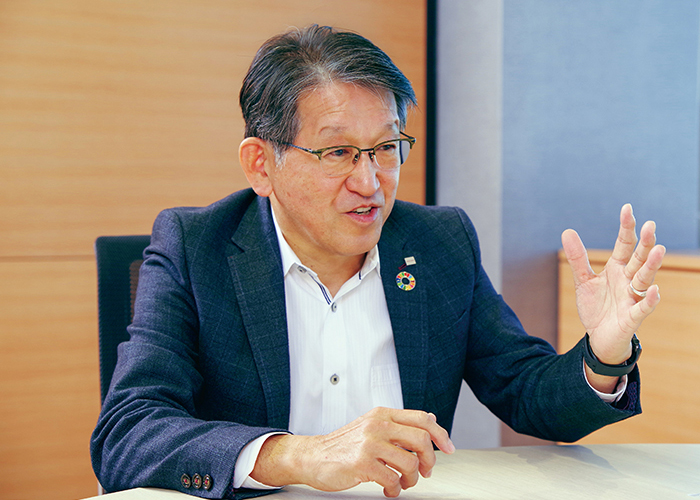
Ideas come from accepting differences
Ahmadjian: That’s right. I think it will be important for you and other senior executives to accept the need for D&I and relate stories about how to achieve it.
Reviewing work practices to create an equitable environment in which Japan can regain its diversity
Ahmadjian: People say, in terms of diversity, that Japan is underdeveloped. But I believe that Japan is actually more diverse than people think. Because the nation stretches so far north to south, there are huge differences in natural features, language, and culture.
Yamashita: That’s certainly true. After the war, however, Japan resolutely pursued a recovery that delivered rapid growth through mass production and consumption and made it a major world player. At that point, everyone safeguarded quality, cost, and delivery standards by heading in the same direction. The resulting successes may have led to an unwritten rule that everyone in Japan must do things the same.
Ahmadjian: But times have changed. Maybe we need to discard the myth of monoculturalism. If you talk to individuals wearing similar clothing, you still find their ideas interesting and unique. So, I think the nation needs to exercise its inherent diversity more.
Yamashita: It’s true that diversity is stifled. We need to unleash it.
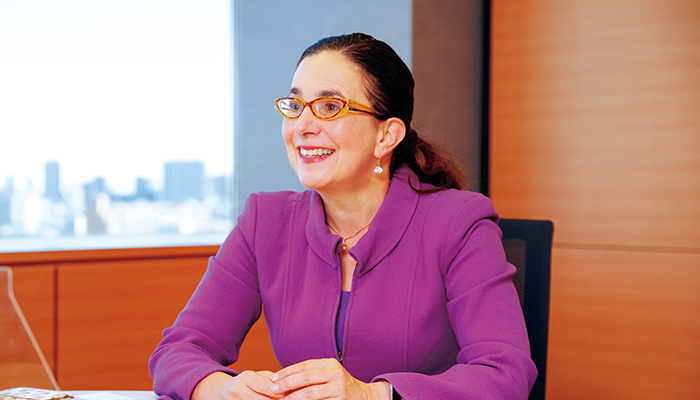
Japan is more diverse than people think…Unleash and exercise its inherent diversity more.
Ahmadjian: Japan first needs to reform work practices to regain its diversity and become more inclusive. It will also be vital to deploy output-based evaluation systems that both employees and management accept.
Yamashita: Soon after I took the helm at Ricoh in 2017, I initiated a project to encourage diverse work practices. The basic idea was for people to demonstrate their skills and deliver good output, although the rules proved a little inadequate in some cases. For example, some people found it hard to get to work on time because they had to take their children to school. That put pressure on people because they risked breaking company rules. We eliminated such situations as much as possible by increasing working day alternatives and striving to create environments where everyone can fulfill their potential. These efforts accelerated and bore fruit after the COVID-19 pandemic began.
Implementing a job-based employment structure and trusting people rather than worrying about them
Yamashita: The other need that you mentioned is for output-based evaluation systems. For a start, our work practice reforms have visualized work and the people performing it, enabling us to have a better understanding. As teleworking has become the standard, supervisors have had to assess employees based on outcome and become accustomed to setting firm key performance indicators. So, we can now run our systems properly. It is partly against that backdrop that we plan to roll out a proprietary job description-based employment structure in April 2022.
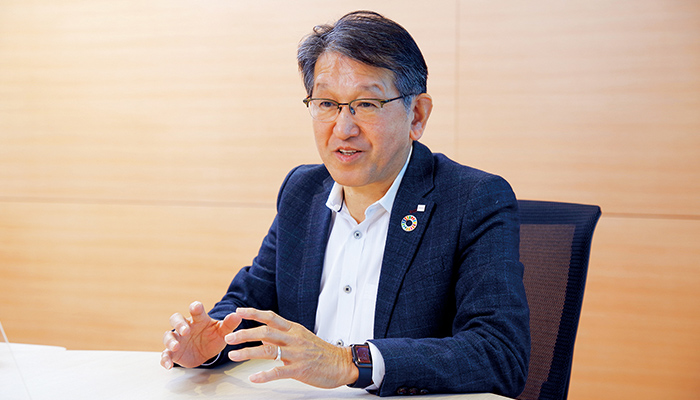
Ahmadjian: More and more Japanese companies have adopted job description-based setups, often unsuccessfully. But your explanation offered hope because you have put in place such requirements as visualization and key performance indicators. I might add that it is important to maintain a culture in which people feel free to discuss anything, including by offering suggestions to their supervisors.
Yamashita: You’re right. Good communication is another requirement for a job-based model. You particularly need trust between supervisors and the people they oversee. Supervisors tend to fret about their subordinates, but they have to relax a little and trust them. It’s an essential shift.
Ahmadjian: That requires good management skills. These days, the curricula of top business schools overseas emphasize communication, diversity stories, and other soft skills more than other business capabilities such as frameworks. People may need specific training to bring them up to date.
Becoming truly global by accommodating diverse perspectives
Yamashita: I’m always exploring ways to foster diversity. I think it’s also key to gain new perspectives and insights by offering workations and encouraging employees to communicate with people outside Ricoh. Such engagement has generated new ideas under TRIBUS, our internal accelerator program.
Ahmadjian: Experiences outside daily routines are very important. Workations are remarkable and effective vehicles to communicate with people you wouldn’t normally encounter.
Yamashita: The Ricoh Group has fostered local diversity in its drive to build a global presence. I was posted for many years in the United Kingdom and the United States. When you go global, it’s natural for people of various nationalities, and women managers for that matter, to be collegial. It will be critical for us to embrace diversity and differing values and teamwork to progress and innovate worldwide in the coming years. We formulated our Global Diversity and Inclusion Policy to demonstrate our commitment to understanding, safeguarding, and implementing D&I.
Ahmadjian: The Ricoh Group has high percentages of women employees and women in managerial positions worldwide. So, it’s significant that you put together your Global Diversity and Inclusion Policy. What sorts of initiatives are you undertaking in your operating regions?
Yamashita: Every year, we host events in each operating region on the theme of women’s activities that commemorate International Women’s Day on March 8. In Europe, the Diversity & Inclusion Advisory Council regularly discusses matters with board members and deploys measures and activities to embed D&I in the corporate culture. A recent exchange of ideas highlighted the challenges that people with disabilities face and the need for greater inclusiveness for these individuals. In the United States, we hold monthly events on such themes as Black History Month and Diversity Awareness. The Diversity and Inclusion Advisory Council supports these activities. In Asia and other regions in which we do business, we undertake D&I initiatives that we customize for local circumstances.
Ahmadjian: There are lots of good examples. Many people could be role models for women’s empowerment. Japanese companies ought to learn as much as possible from what’s happening overseas.
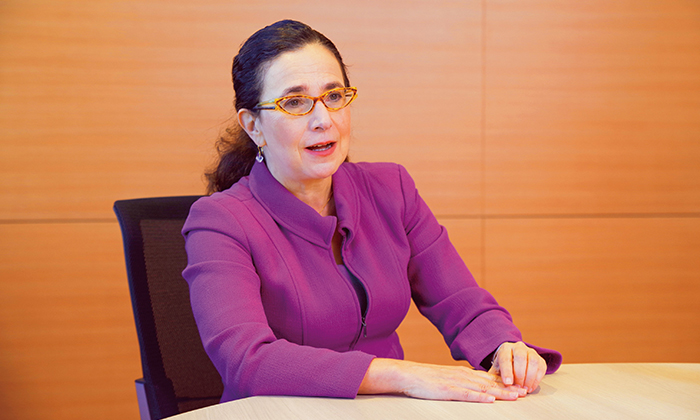
Yamashita: True. We’d like to increase knowledge-sharing opportunities. Examples could include how D&I initiatives have motivated employees and revitalized Ricoh or how we’ve communicated better with customers. It will be essential for Ricoh to generate value when engaging with customers to become a digital services company. We’d therefore like to learn more from successes around the world and foster better understanding of others.
Ahmadjian: Being a global company means you have to meet global standards in the domestic market. Mutual learning and understanding are therefore important. I look forward to seeing innovations from the Ricoh Group as it progresses with D&I.
“Jump out of your comfort zone” “Put your thoughts into words and give them shape”
Ahmadjian: My initial recommendation to Ricoh Group employees would be to say, “Jump out of your comfort zone.” I tell my students that if they want to do something, they should say so and act on it. Being an order taker gets you nowhere. Even if your efforts aren’t well-received, it’s important to believe in yourself and keep going. I’d like executives to support employee efforts. If management stays the same, your people can’t change anything no matter how hard they try.
Yamashita: My message has a similar intent, which is to put your thoughts into words and give them shape. I encourage people to express their ideas in their own words and then act to bring them to fruition. I think it’s my job to make the corporate culture more conducive to such progress and offer programs that broaden opportunities for action. If each and every employee in the Ricoh Group makes an effort, diversity will produce innovations. I look forward to hearing what our people think, say, and do. Thank you very much, Christina, for taking the time to talk with me today.
*: Business for Inclusive Growth combats income and opportunity inequalities through a coalition of more than 30 leading multinational companies, principally in Europe and the United States.
Note: Both speakers wore masks throughout the discussion, except for removing them briefly for the photographer.